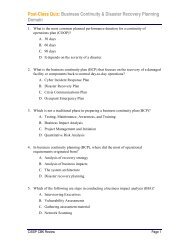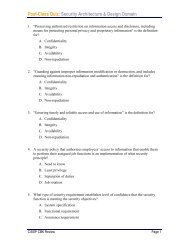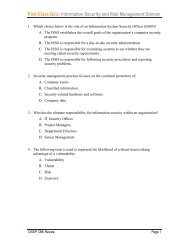Intrusion Detection
Social Engineering - OpenSecurityTraining.info
Social Engineering - OpenSecurityTraining.info
- No tags were found...
You also want an ePaper? Increase the reach of your titles
YUMPU automatically turns print PDFs into web optimized ePapers that Google loves.
Hacking Techniques &<br />
<strong>Intrusion</strong> <strong>Detection</strong><br />
Ali Al-Shemery<br />
arabnix [at] gmail
# whoami<br />
• Ali Al-Shemery<br />
• Ph.D., MS.c., and BS.c., Jordan<br />
• More than 14 years of Technical Background (mainly<br />
Linux/Unix and Infosec)<br />
• Technical Instructor for more than 10 years (Infosec,<br />
and Linux Courses)<br />
• Hold more than 15 well known Technical Certificates<br />
• Infosec & Linux are my main Interests<br />
3
Welcome<br />
Please introduce yourself:<br />
• Name:<br />
• Work:<br />
• Why Infosec degree?<br />
• Any Technical Background?<br />
4
Social Engineering
Kickstarting Notes<br />
• The course will cover different topics from an<br />
offensive point of view,<br />
• Mitigation and remediation steps will be<br />
provided for each subject of the course,<br />
• Backtrack Linux is used to perform the attacks,<br />
• Don’t depend on the course’s slide notes!<br />
6
Outline - Social Engineering<br />
• Intro.<br />
• Information Gathering<br />
• Elicitation<br />
• Pretexting: How to Become Anyone!<br />
• Mind Tricks: Psychological Principles Used in<br />
Social Engineering<br />
• Tools Used<br />
7
Why Start the course<br />
with Social Engineering<br />
?
Social Engineering<br />
“You could spend a fortune purchasing<br />
technology and services from every<br />
exhibitor, speaker and sponsor at the RSA<br />
Conference, and your network<br />
infrastructure could still remain vulnerable<br />
to old-fashioned manipulation.”<br />
Kevin Mitnick
Definition SE<br />
―The act of manipulating a person to<br />
take an action that may or may not be<br />
in the ―target’s‖ best interest. This<br />
may include obtaining information,<br />
gaining access, or getting the target to<br />
take certain action.‖<br />
– Christopher Hadnagy<br />
10
Why Attackers Might Use<br />
Social Engineering?<br />
• No technology in the world can prevent<br />
social engineering!<br />
• Because there is no patch for human<br />
stupidity!<br />
• People are the largest vulnerability in any<br />
network or security chain!<br />
• Path of Least Resistance<br />
– Why spend hours, days, weeks to crack a<br />
password when you can just ask for it?<br />
• On The Rise<br />
– Phishing attacks are rising 26% per month!<br />
11
Categories of Social Engineers<br />
• Hackers<br />
• Penetration Testers<br />
• Spies or Espionage<br />
• Identity Thieves<br />
• Disgruntled Employees<br />
• Information Brokers<br />
• Scam Artists<br />
• Executive Recruiters<br />
• Sales People<br />
• Governments<br />
• Everyday People<br />
12
Typical Goals of a Social<br />
Engineer<br />
• Dr. Max Kilger (Honeynet Project)<br />
identified six motivations for nonethical<br />
computer activity:<br />
– Money, Entertainment, Ego, Cause,<br />
Entrance into a social group, and Status<br />
within that social group<br />
• Other key motivations:<br />
– knowledge, revenge and curiosity.<br />
• Social Engineering as a Protection<br />
13
Classic Social Engineering<br />
Attacks<br />
• Username / Password Information<br />
• Credit Information<br />
• Name & Address Information<br />
• Procedures<br />
• PIN Codes<br />
Impersonation<br />
In Person<br />
Dumpster Diving<br />
Shoulder Surfing<br />
Websites<br />
14
Real World Social Engineering<br />
Examples<br />
• Playing the Part<br />
• Opposite Sex<br />
• Confidence Men (Con Men)<br />
• Phishing (more on this coming)<br />
• Politicians<br />
15
Phishing<br />
In the field of computer security:<br />
• ―Phishing is the criminally fraudulent process of<br />
attempting to acquire sensitive information such as<br />
usernames, passwords and credit card details by<br />
masquerading as a trustworthy entity in an<br />
electronic communication".<br />
• Examples:<br />
– URL and Email Manipulation<br />
• A URL like (http://www.company.com) looks almost identical to<br />
(http://www.cornpany.com)<br />
– Spear Phishing<br />
– Penetration Testers and Social Engineers<br />
16
Information Gathering<br />
• Human Intelligence (HUMINT)<br />
• Signals Intelligence (SIGINT)<br />
• Open Source Intelligence (OSINT)<br />
• Imagery Intelligence (IMINT)<br />
– Will be discussed next week.<br />
17
ELICITATION<br />
―Elicitation is the process of extracting<br />
information from something or<br />
someone.‖<br />
– NASA
Elicitation Goals<br />
• Elicitation is used to get to know<br />
people better.<br />
• Used to make mental judgments of<br />
IF and HOW to develop a<br />
relationship with a person.<br />
• In the case of an individual or<br />
group of people, this is something<br />
we do everyday by talking,<br />
listening, and asking questions.<br />
19
Elicitation Preloading<br />
• Preloading is influencing subjects<br />
before the event.<br />
• Think about a movie's pre-release<br />
trailers.<br />
• They use desired outcome words such<br />
as ―The best film you have ever seen!‖<br />
• This technique works great when<br />
introducing anything.<br />
20
Becoming a Successful<br />
Elicitor<br />
• Understand how to communicate with people.<br />
• Must learn to be adaptive (communication must be made to<br />
fit the environment and situation).<br />
• Build a bond or relationship with the potential "target".<br />
• Communications should match your pretext, otherwise you<br />
might seem out of place to the people your communicating<br />
with. If your pretext is a member of the IT staff then you need<br />
to know, understand, and be able to effectively communicate<br />
enough technical information to appear convincing.<br />
• You must know how to ask intelligent questions that will<br />
force a response. Questions that can be answered with a<br />
simple "Yes" or "No" are not good questions at all.<br />
21
Types of Questions<br />
• Open Ended<br />
• Close Ended<br />
• Neutral<br />
• Leading<br />
• Assumptive<br />
22
Key Points<br />
• Important key points in mind:<br />
– Too many questions can shut down the<br />
interaction<br />
– Too little may make the person uncomfortable<br />
– Ask only one question at a time, too many will<br />
cloud the answer you get<br />
– Use a narrowing approach to questions to gain<br />
the most information<br />
i.e. Neutral Questions -----> Open Ended -----<br />
> Closed Ended -----> Highly Directed<br />
23
PRETEXTING:<br />
How to Become Anyone!<br />
―True social engineering is not just<br />
believing you are playing a part, but for<br />
that moment you are that person, you<br />
are that role, it is what your life is.‖<br />
– Chris Nickerson
Definition<br />
• Pretexting is a social engineering technique<br />
wherein a hacker uses false pretenses to engage<br />
with his/her intended victim in order to get<br />
information from that target.<br />
• Basically it’s a lie with a made-up story to go along<br />
with it. Pretexting is often used to gain trust, and<br />
when trust is gained by the pretexter, data and<br />
privacy are in danger.<br />
―Honesty is the key to a relationship. If you can fake<br />
that, you’re in.‖<br />
• —Richard Jeni<br />
25
Importance of Pretexting<br />
• One of the most important aspects of social<br />
engineering is trust. If you cannot build trust<br />
you will most likely fail.<br />
• A solid pretext is an essential part of<br />
building trust.<br />
• If your alias, story, or identity has holes or<br />
lacks credibility or even the perception of<br />
credibility the target will most likely catch<br />
on.<br />
26
Pretexting Principles and<br />
Planning<br />
• A crucial aspect of using pretexting as a social<br />
engineering tactic is proper planning.<br />
• If proper planning is not taken, the percentage of your<br />
social engineering attempts that will succeed will be few<br />
to none.<br />
– Basic Principles<br />
– Planning and Using Pretexts<br />
– Character Creation<br />
• Trust Relationships<br />
27
Basic Principles<br />
• The more research that is done the better chance of success<br />
• Careful planning is required for success<br />
• Practicing dialects or expressions that will be familiar to your<br />
target is essential<br />
• Just because the pretext is over the phone does not minimize<br />
the research effort<br />
• The simpler the pretext the better chance of success<br />
• Your pretext should appear spontaneous<br />
• Your pretext should seem accurate or have aspects that are<br />
not susceptible to verification<br />
• You must know the intelligence and type of person you will<br />
be contacting<br />
28
Planning and Using Pretexts<br />
• Pretexting has been hailed as one of the quickest<br />
ways to obtain information.<br />
• Utilized by federal and local law enforcement,<br />
private detectives, reporters, interrogators and<br />
many other types of people.<br />
• While selecting your pretext it is imperative to<br />
consider a few key questions:<br />
– What problem am I trying to solve?<br />
– What questions am I trying to answer?<br />
– What information do I seek?<br />
– The nature of the person whom we will be contacting<br />
29
Character Creation<br />
• When you're developing a pretext you are essentially<br />
creating a character.<br />
• The complexity of that character is determined by the<br />
planned depth of interaction with people at the target<br />
site.<br />
• A pretext can be as simple as just being friendly to<br />
someone during a conversation or as complicated as a<br />
full blown fake identity complete with ID’s, public<br />
records, and all the trappings of a normal person’s life<br />
(social networking pages, blog postings, and other<br />
things searchable via the Internet).<br />
• The process of character development is well<br />
documented and practiced by the acting community.<br />
30
Mind Tricks<br />
Psychological Principles Used<br />
in Social Engineering
PSYCHOLOGICAL<br />
PRINCIPLES<br />
―Simply confirming your nonverbal behavior<br />
to the client, using language from the<br />
client’s preferred representational system<br />
and matching speech volume, tone and area<br />
of speech often overcomes client reluctance<br />
to communicate.‖<br />
– Subtle Skills for Building Rapport, FBI<br />
32
Modes of Thinking<br />
• To alter someone’s way of thinking you must<br />
understand the way people think and in what<br />
modes they think.<br />
• A basic question will come in mind “How do I<br />
figure out a target’s dominant mode of<br />
thinking?”<br />
– The Senses<br />
– Micro-Expressions<br />
– Neurolinguistic Programming (NLP)<br />
33
The Three Main Modes of<br />
Thinking<br />
• Although we have five senses, the modes of<br />
thinking are associated with only three of<br />
them:<br />
– Sight, or a visual thinker<br />
– Hearing, or an auditory thinker<br />
– Feeling, or a kinesthetic thinker<br />
34
• Anger<br />
• Disgust<br />
• Fear<br />
• Joy<br />
• Sadness<br />
• Surprise<br />
Micro-Expressions<br />
35
Anger<br />
Disgust<br />
Fear<br />
Contempt<br />
Sadness<br />
Happiness<br />
36
Training Yourself to See<br />
Microexpressions<br />
• Replay expression videos to see how each part<br />
of the face is involved.<br />
• Perform the ME yourself using a mirror.<br />
37
Benefits of ME Training<br />
• Combine the skill with:<br />
– interrogation tactics,<br />
– body language skills,<br />
– and elicitation skills to not only figure out what<br />
targets are thinking, but also to lead them down<br />
the path you want.<br />
38
You’re not a Mind Reader!<br />
• The expression is linked to an emotion, but<br />
the expression doesn’t tell you why the<br />
emotion is being displayed.<br />
39
How to Use ME as a Social<br />
Engineer<br />
• Eliciting or causing an emotion<br />
• Detecting deception<br />
– Contradictions<br />
– Hesitation<br />
– Changes in behavior<br />
– Hand gestures<br />
40
Neurolinguistic Programming<br />
(NLP)<br />
• “a model of interpersonal communication chiefly<br />
concerned with the relationship between<br />
successful patterns of behavior and the subjective<br />
experiences (esp. patterns of thought) underlying<br />
them,”<br />
• and “a system of alternative therapy based on<br />
this which seeks to educate people in selfawareness<br />
and effective communication, and to<br />
change their patterns of mental and emotional<br />
behavior.”<br />
– Oxford English Dictionary<br />
41
How to Use NLP as a Social<br />
Engineer<br />
• Many of the scripts and principles of NLP tend<br />
to lean toward hypnosis and similar avenues.<br />
• Even though you will not use hypnosis to<br />
social engineer a target, you can use many of<br />
the principles of NLP as a social engineer.<br />
• For example, NLP can teach you how to use<br />
your voice, language, and choice of words to<br />
guide people down the path you want.<br />
42
SOCIAL ENGINEERING<br />
TOOLS
Physical Tools<br />
• Lock Picking and Shims<br />
• (Shove Knife,<br />
• Bump Keys,<br />
• Shims)<br />
• Snap Gun.<br />
44
Physical Tools – Cont.<br />
• Cameras (Small/Compact, Cell<br />
Phones, Covert, Qik)<br />
• GPS Tracker (SpyHawk, SuperTrack)<br />
• Pen Recorder<br />
• RF Bug Kits<br />
45
Computer Based Tools<br />
• Maltego<br />
46
Computer Based Tools – Cont.<br />
• Social Engineer Toolkit (SET)<br />
• Common User Passwords Profiler<br />
(CUPP)<br />
• Who's Your Daddy Password Profiler<br />
(WYD)<br />
• Dradis, BaskKet – Information<br />
Gathering<br />
47
Phone Based Tools<br />
• Caller ID Spoofing<br />
– SpoofCard<br />
– Asterisk<br />
– SpoofApp<br />
– Voicemail<br />
48
Social Engineering<br />
• Countermeasure<br />
• Mitigation<br />
• Remediation<br />
?<br />
49
SUMMARY<br />
• How hackers manipulate people to reach<br />
information using Social Engineering<br />
techniques,<br />
• Who are Social Engineers,<br />
• The Tools used by Social Engineers,<br />
• Countermeasures, Mitigation, and<br />
Remediation for Social Engineering.<br />
50
References<br />
[-] Social Engineering Framework, http://www.socialengineer.org/framework/<br />
[-] Chris Nickerson, a well-known social engineer from the TV<br />
series Tiger Team<br />
[-] Dr. Max Kilger, motivations, http://www.socialengineer.org/wiki/archives/TypicalGoals/TypicalGoalsrdodge.pdf<br />
[-] Social Engineering: The Art of Human Hacking, Chris Hadnagy<br />
[-] NASA SE definition, http://socialengineer.org/wiki/archives/Elicitation/Definition_of_Elicitation.<br />
htm<br />
51

















